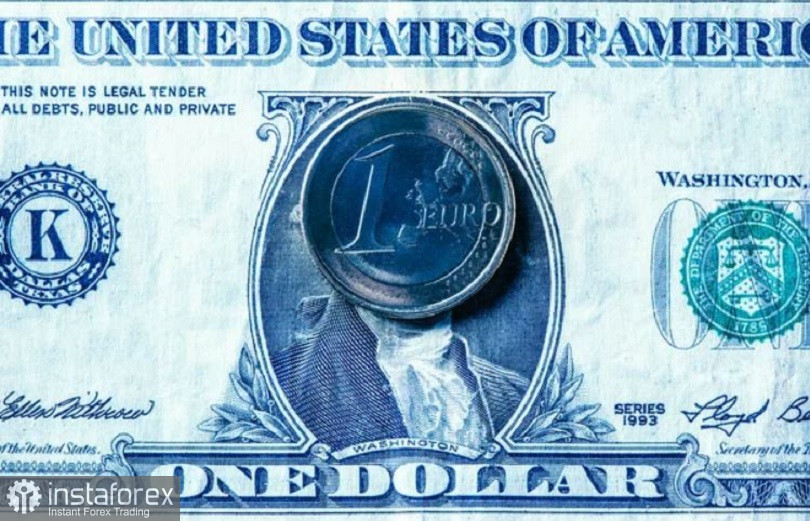So, the euro-dollar pair returned to the parity level. The last time the price stayed in this area was in mid-July when the bears managed to update the 20-year price low, reaching 0.9963. However, the sellers failed to gain a foothold below the target of 1.0000 – this support level held back the onslaught of EUR/USD bears. As a result, a price bottom was formed, to which traders did not dare to return for more than four weeks.
The current downward impulse is due to the general strengthening of the greenback with a simultaneous weakening of the European currency. The worsening energy crisis is putting pressure on the euro and reinforcing anti-risk sentiment in the market, thus boosting demand for the safe-haven dollar. Such a "recursion" allowed EUR/USD sellers to organize a powerful and almost recoilless downward shaft. As of this writing, traders are reconnaissance by force, testing the 1.0000 price barrier.

It is noteworthy that the pair is falling against an almost empty economic calendar. Today, in fact, there are two releases for EUR/USD: the monthly report of the Bundesbank and the business activity index calculated by the Chicago Fed. These are not even secondary but third-rate fundamental factors, so it is obvious that the pair dives down on the same yeast that it fell on at the end of last week.
Thus, this morning the price of gas in Europe, for the first time since March, exceeded the psychologically important mark of $3,000 per thousand cubic meters. And judging by the dynamics of price growth, Gazprom's gloomy forecasts that the price tag will be at the level of 4,000 in winter may come true ahead of schedule, even before the onset of cold weather.
The European currency painfully reacts to the growth in the cost of blue fuel. There are more and more fears in the press that during the autumn-winter period, Europeans may face not only a reduction in industrial production and a further increase in inflation, but also large-scale power outages. Given such prospects, the euro has been under constant background pressure for several months now. Note that gas prices in Europe rose sharply at the end of July, after the Russian Federation announced a reduction in gas exports via Nord Stream to 20% of the design capacity. Gazprom argued this decision by violating the maintenance schedule for the equipment of the starting station of the sea main—the Portovaya compressor station. Then blue fuel rose in price to $2,500, but then the price rolled back.
Today's price jump is an echo of the events of the last week. On Friday, Gazprom announced that only Nord Stream turbine would be shut down on August 31 for repairs. According to preliminary data, the repair work will last at least three days. This means that for three days, gas will not be supplied through this pipeline at all: the supply of blue fuel through the Nord Stream will be completely stopped for this time. It is expected that after the completion of the work, the capacity of the gas pipeline will be restored, but only up to 20% of the total capacity.
The worsening energy crisis allows EUR/USD sellers to probe the 1.0000 support level as the safe dollar is in high demand due to European concerns while the euro is under extreme pressure. In addition, the greenback is strengthening its position on the eve of the economic symposium in Jackson Hole. Despite the first signs of a slowdown in the consumer price index, Fed Chairman Jerome Powell may sound hawkish, saying that inflation is still at a high level (the CPI slowdown was due to lower fuel prices, many other components showed growth). In addition, the head of the Fed may focus on the dynamics of the US labor market, given the fact that the latest Nonfarm Payrolls was much better than expected. Powell is also expected to discuss the Fed's plans on balance sheet reduction.
Thus, a combination of fundamental factors brought the EUR/USD pair to the parity level. Of course, this is a kind of triumph for the bears, but at the same time it is their headache since short positions around the 1.0000 mark are very risky.
In July, when EUR/USD sellers tested this price barrier for the first time in the last 20 years, they acted extremely cautiously, systematically probing it. One single attempt to gain a foothold under this target failed: the pair bounced off the 0.9953 mark and never returned to this price area. Therefore, now, when sellers are testing the 1.0000 mark, a natural question arises: should I enter into sales on the current bottoms? After all, the risk of catching the price bottom at such lows is quite high, given the sacredness of parity. In my opinion, such concerns of traders are quite justified: in August, the "July scenario" may well repeat when buyers used the parity level (and short-term "diving" into the area of the 99th figure) as a springboard for a large-scale correction.
Therefore, despite the prevailing fundamental background, I do not recommend opening short positions near the 1.0000 mark. It is advisable to enter sales on corrective pullbacks to the area of 1.0100–1.0150. In this case, the downward targets will be 1.0050 and 1.0010. At the same time, longs in any case look extremely risky, given the vulnerability of the European currency.
 English
English 
 Русский
Русский Bahasa Indonesia
Bahasa Indonesia Bahasa Malay
Bahasa Malay ไทย
ไทย Español
Español Deutsch
Deutsch Български
Български Français
Français Tiếng Việt
Tiếng Việt 中文
中文 বাংলা
বাংলা हिन्दी
हिन्दी Čeština
Čeština Українська
Українська Română
Română

